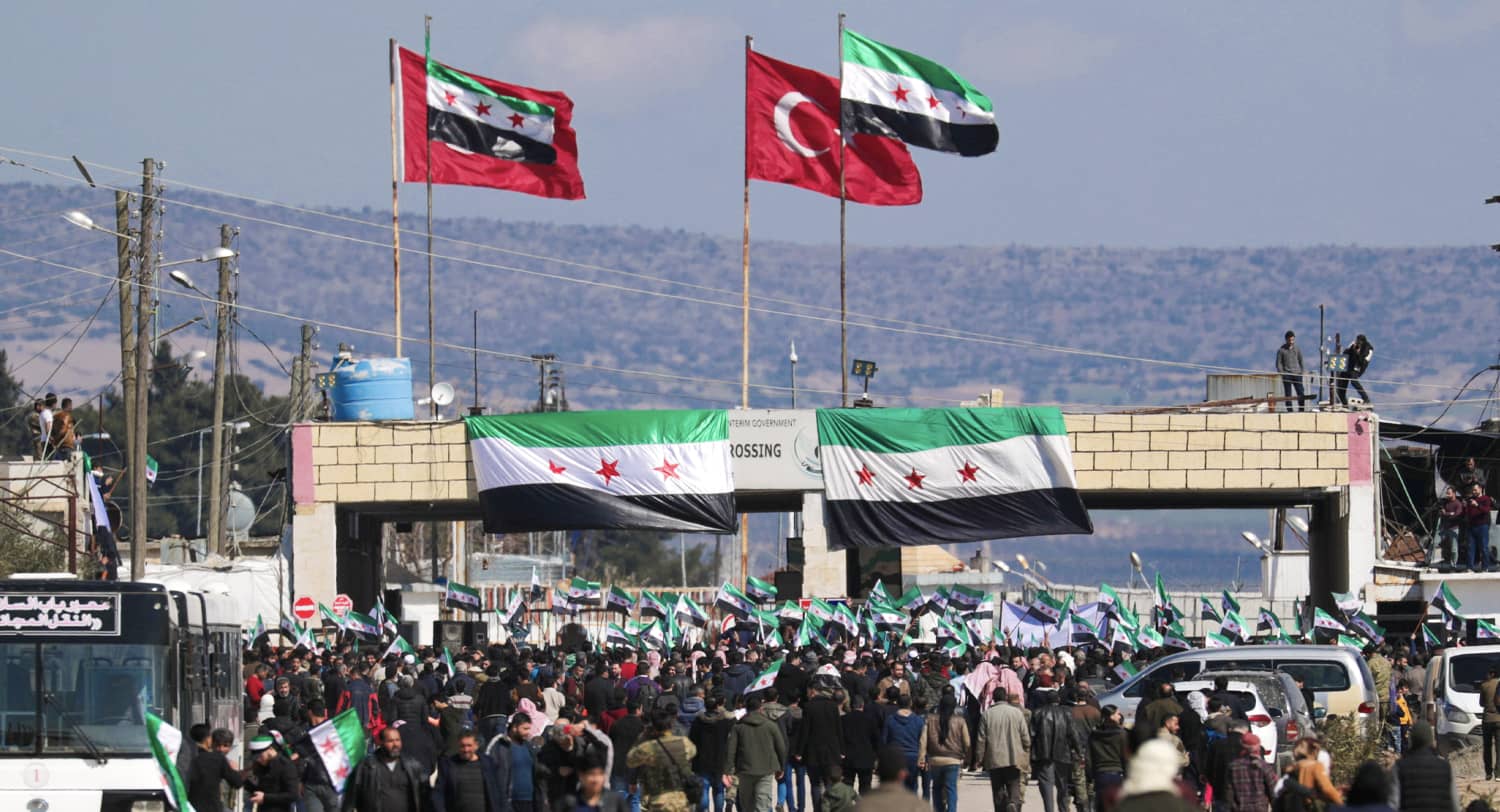Syria’s civil war broke out in March 2011, in reaction to the brutal crackdown by the regime of Bashar al-Asad of popular protests that were part of the wider Arab Spring.
In supporting the Syrian rebels, Turkey’s President Recep Tayyip Erdoğan initially used the language of humanitarian intervention, claiming to protect civilians from the Asad regime’s repression. But it soon became clear that Erdoğan was also seeking regime change, motivated by an ideological goal: replacing Asad’s secular Arab nationalist regime with an Islamist government. This new Syria would then support Turkey’s leadership of a new Sunni Muslim order in the Levant.
Early in the conflict, Erdoğan and then-Foreign Minister Ahmet Davutoğlu declared that Turkey could not stand idly by while Asad’s regime silenced the cries of freedom of Syria’s Sunni majority. Publicly, they urged Asad to implement democratic reforms. Privately, Davutoğlu assured Erdoğan that Asad’s fall was imminent, either through internal collapse or Western intervention, as had occurred in Libya and Egypt.
But Turkey lacked the capacity to orchestrate regime change in its southern neighbor. What it possessed was a growing willingness to support jihadist elements in the Syrian opposition.
By mid-2011, Turkey transitioned from diplomatic pressure to active support of the rebels. Ankara allowed the Syrian opposition to organize on Turkish soil, enabling the formation of groups like the “Friends of Syria” and the Free Syrian Army. Foreign fighters traveled to Turkey to join the anti-Asad ranks. Turkey became a hub for Syria’s rebellion.
Turkey, led by the AKP, cast itself as the model Sunni democracy – exporting this “Turkish Model” to Arab Spring nations.
In October 2011, Turkey helped launch the Syrian National Council in Istanbul. Though intended as a broad opposition umbrella, it became dominated by the Syrian branch of the Muslim Brotherhood. At a 2012 State Department meeting, Syrian Kurdish representatives complained that “with the support of Turkey,” the Brotherhood had sidelined other opposition voices. One US official summarized Ankara’s vision as “a centralized Islamist government backed by a constitution.”
When Turkey convened the Syrian opposition in Antalya in December 2012 to form a new command structure, nearly two-thirds of the delegates invited were Muslim Brotherhood members. Turkey’s vision for Syria was now plainly visible: a Brotherhood-led regime beholden to Ankara.
But Asad did not fall. As the civil war dragged on, Turkey doubled down, providing covert aid to rebel groups. Hakan Fidan, head of Turkey’s intelligence agency MIT, directed this support. According to The Wall Street Journal, MIT became a “traffic cop” coordinating weapons shipments and directing convoys across the 565-mile Turkish-Syrian border.
By early 2012, the insurgency had changed. Extremist factions, initially peripheral, began to dominate, including Jabhat al-Nusra [al-Nusra Front]. It established cells across Syria, in Aleppo, Idlib, Deir al-Zor, and Dera’a. Another Islamist group, Ahrar al-Sham, formed in January 2012. By the end of the year, it joined ten other militias to create the Syrian Islamic Front. In 2013, it evolved into Harakat Ahrar al-Sham al-Islamiyya and collaborated with jihadist and US-backed groups alike.
All these groups benefited from Turkey’s open-door policy. One US official described Turkey’s border approach as a revolving door: “They more or less let all kinds of people in – al-Nusra was among them. ” Turkish border guards “looked the other way,” allowing jihadists to cross with impunity. In December 2012, the US designated al-Nusra as a foreign terrorist organization highlighting its ties to al-Qai’da.
By May 2013, the White House was alarmed. President Obama reportedly warned Erdoğan that Turkey was “letting arms and fighters flow into Syria indiscriminately and sometimes to the wrong rebels, including anti-Western jihadists.” US officials pressed Ankara to “tightly control the arms flow.”
Turkey was the central artery of what analysts dubbed the “jihadi highway.” Norwegian terrorism expert Thomas Heghammer noted, “Turkey is to Syria now what Pakistan was to Afghanistan in the 1990s. Antakya is the Peshawar of Syria.” Fighters flowed in from across the world. Turkish border towns became staging grounds for Islamist militias. Local shops sold smartphones and supplies to jihadists. Hospitals treated wounded fighters from both ISIS and al-Nusra. Mehmet Ali Ediboğlu, a Turkish member of parliament from the opposition CHP, told The Wall Street Journal that he personally tracked “a convoy of more than 50 buses carrying radical fighters” to the border, escorted by Turkish police.
Weapons also streamed across the border. Reuters reported in 2012 that Turkey, Saudi Arabia, and Qatar had established a secret operations center near the border to coordinate arms and communications for Syrian rebels. Washington was complicit. Francis Ricciardone, former US ambassador to Turkey, said in 2014 that Ankara “worked with groups for a period, including al-Nusra,” and hoped to “moderate” them.
When Davutoğlu was pressed about al-Nusra’s links to al-Qa’ida, he merely admitted, “declaring them [al-Nusra] a terrorist organization has resulted in more harm than good.”
Erdoğan and Davutoğlu’s pursuit of regime change was not a defensive reaction to Asad’s brutality. It was an effort to remake the region in the AKP’s Islamist image. And in that reckless endeavor, they opened the gates to forces far beyond their control, including the terrorist ISIS caliphate.
This is Part III of a series of reports by Sinan Ciddi on Turkey’s role in Syria.

